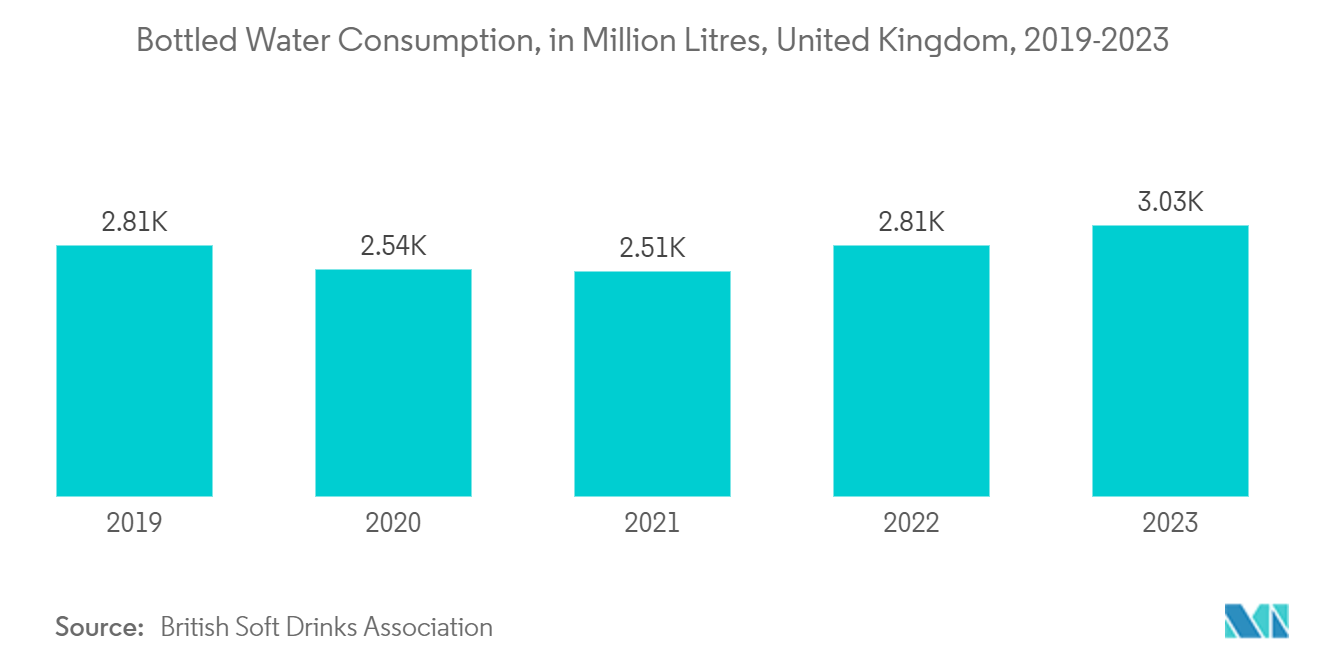Market Trends of Europe Plastic Bottles Industry
Strong Demand From the Beverage Segment Driving the Market
- The beverage segment is propelling significant growth in the market studied. As plastic bottles gain traction in this segment, manufacturers are expanding their focus beyond beverages to cater to diverse end-use industries. Lightweight packaging, due to its economic efficiency and environmental benefits, has become a cornerstone of the packaging industry. The lightweight nature of plastic bottles and containers not only curtails energy consumption during transportation but also translates to reduced fuel usage, lower carbon emissions, and cost savings for distributors and retailers. This trend is particularly significant as companies strive to meet stringent environmental regulations and consumer demand for sustainable practices.
- According to the 2024 Annual Report by the British Soft Drink Association, the United Kingdom consumed 3,027 million liters of bottled water in 2023, with a staggering 95.2% of that volume in plastic bottles. As bottled water consumption continues its upward trajectory, the beverage segment’s demand for rigid plastic bottles is poised to escalate. This increase in demand is driven by increased consumer preferences for convenience and portability, as well as the growing awareness of the health benefits associated with bottled water.
- Plastic bottles dominate the UK beverage market, owing to their cost-effectiveness and barrier properties. They account for 68% of soft drink consumption, 53% of carbonated drinks, 95% of dilutables, and 42% of sports and energy drinks, as per findings from the British Soft Drink Association. The versatility and durability of plastic bottles make them an ideal choice for various beverage types, ensuring product safety and extending shelf life. Additionally, advancements in plastic bottle manufacturing technology have enhanced their appeal by improving their recyclability and reducing their environmental footprint.
- The European plastic bottles market is witnessing a pronounced shift toward sustainability. Initiatives include adopting sustainable raw materials like bioplastics and incorporating recycled content into product lines. With the Single-Use Plastic Directive setting ambitious targets of 25% recycled content by 2025 and 30% by 2030, the industry is on the brink of transformation. In response, manufacturers are channeling investments into recycling technologies, underscoring their commitment to sustainability. These efforts are not only driven by regulatory requirements but also by the increasing consumer demand for eco-friendly products. Companies that successfully integrate sustainability into their operations are likely to gain a competitive edge in the market.
- As beverage consumption surges, so does the demand for plastic bottles and containers across the board, be it for bottled water, carbonated drinks, or milk. Highlighting this trend, Germany's per capita soft drink consumption jumped from 114.7 liters in 2020 to an anticipated 124.9 liters in 2023, showcasing the nation's strong demand for plastic packaging. This growth is indicative of broader trends in the European market, where convenience and lifestyle changes are driving increased consumption of packaged beverages. The rising demand for plastic packaging solutions presents both opportunities and challenges for manufacturers, driving the need for innovation with the imperative of sustainability.

Germany Expected to Witness Significant Market Growth
- Driven by advancements from both solution providers and end users, Germany is increasingly adopting plastic packaging solutions. The region's flexible packaging companies have notably benefited from the esteemed consumer perception of "Made in Germany" products. This perception has created a competitive edge for local manufacturers, enhancing their market presence and driving demand for innovative packaging solutions.
- In response to the plastic packaging industry's challenges, the German government has enacted stringent regulations. These regulations aim to reduce environmental impact and promote sustainable practices within the industry. While PET bottles are ubiquitous across various segments, polyethylene (PE) bottles lead sales in beverages, cosmetics, sanitary products, and detergents. The regulatory framework has also encouraged companies to invest in research and development, fostering advancements in recyclable and biodegradable packaging materials.
- As cosmetic consumption surges and plastic packaging technology continues to innovate, the market stands on the brink of significant growth. Plastic's lightweight nature, cost-effectiveness, and hygienic properties make it especially ideal for cosmetics, particularly those with shorter shelf lives. PET plastic bottles, being transparent, airtight, easily moldable, and possessing good compressive strength, are not only enhancing the visual appeal of high-end cosmetics but also signaling a bright future for this segment. The ongoing innovations in packaging design and materials are expected to further boost the market, catering to the evolving preferences of consumers and brands alike.
- The German beauty and personal care market is not only robust but also experiencing rapid growth. As reported by Cosmetics Europe, Germany led the European cosmetics market with a significant share in 2023, reaching a valuation of USD 17.36 billion. This thriving luxury cosmetics market in Germany is driving innovations, pushing cosmetic bottle designs toward more aesthetic and appealing forms. The emphasis on premium packaging solutions reflects the growing consumer demand for high-quality and visually attractive products, further propelling the market's expansion.


